
USS Underhill (DE-682) was a Buckley-class destroyer escort of the United States Navy during World War II. Built in 1943, she served in the Atlantic, the Mediterranean, and the Pacific until her sinking in a suicide attack by a Japanese Kaiten manned torpedo on 24 July 1945.

USS Schenck (DD-159) was a Wickes-class destroyer in the United States Navy during World War II. She was named for Rear Admiral James F. Schenck, USN (1807–1882).

USS Evarts (DE-5) was the lead ship of her class of destroyer escorts in the United States Navy.

USS Sturgeon (SS-187), a Salmon-class submarine, was the second ship of the United States Navy to be named for the sturgeon. Its 1944 sinking of the Japanese troopship Toyama Maru, killing more than 5,000 Japanese, was one of the highest death tolls from the sinking of a single ship in history, and its 1942 sinking of the prisoner ship Montevideo Maru was the worst maritime disaster in Australian history.

USS Plymouth (PG-57), a patrol gunboat, was the fourth ship of the United States Navy to be named for Plymouth, Massachusetts, a town founded by the Pilgrims in 1620 on Plymouth Bay, about 35 miles southeast of Boston.

The second USS Buck (DD-420), a World War II-era Sims-class destroyer in the service of the United States Navy, was named after Quartermaster James Buck, a Civil War Medal of Honor recipient. It was built by Philadelphia Naval Shipyard and launched in 1939. It was a member of the convoy carrying the US 1st Provisional Marine Brigade. She served during the Second World War. It was sunk by the German submarine U-616 on 9 October 1943 off the coast of Salerno, when it was working in support of Operation Avalanche. It received 3 battle stars for its services during the Second World War.
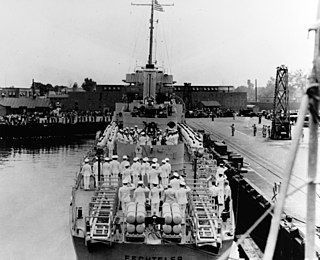
USS Fechteler (DE-157) was a Buckley-class destroyer escort in service with the United States Navy from 1943 to 1944. She was sunk by the German submarine U-967 in the Atlantic Ocean on 5 May 1944.

USS Chase (DE-158/APD-54) was a Buckley-class destroyer escort in service with the United States Navy from 1943 to 1946. She was scrapped in 1946.

USS Laning (DE-159/APD-55) was a Buckley-class destroyer escort in service with the United States Navy from 1943 to 1946 and from 1951 to 1957. She was scrapped in 1975.

USS Mason (DE-529), an Evarts-class destroyer escort, was the second ship of the United States Navy to be named Mason, though DE-529 was the only one specifically named for Ensign Newton Henry Mason. USS Mason was one of two US Navy ships with largely African-American crews in World War II. The other was USS PC-1264, a submarine chaser. These two ships were manned by African Americans as the result of a letter sent to President Roosevelt by the NAACP in mid-December 1941. Entering service in 1944, the vessel was used for convoy duty in the Battle of the Atlantic for the remainder of the war. Following the war, Mason was sold for scrap and broken up in 1947.

USS Atherton (DE-169), a Cannon-class destroyer escort, was the only ship of the United States Navy to be named for Lt. (jg) John McDougal Atherton, who died when USS Meredith sank near Guadalcanal during World War II.
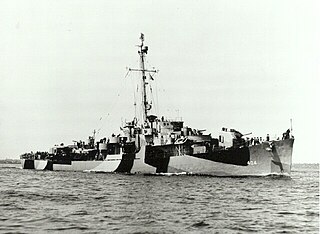
USS Eversole (DE-404) was a John C. Butler-class destroyer escort built for the United States Navy during World War II. Named for Lieutenant John Thomas Eversole,, she was the first of two U.S. Naval vessels to bear the name. The vessel was torpedoed and sunk on 28 October 1944.

USS Roche (DE-197) was a Cannon-class destroyer escort in service United States Navy from 1944 to 1945. She hit a mine in late September 1945. As it was uneconomical to repair her, she was scuttled in March 1946.

USS Sentinel (AM-113) was an Auk-class minesweeper built for the United States Navy during World War II; she was the third U.S. Naval vessel to bear the name. It was laid down on 28 November 1941 by the American Ship Building Company, Cleveland, Ohio; launched on 23 May 1942; and commissioned on 3 November 1942, Lt. Comdr. George Lincoln Phillips, USNR, in command.

USS Steady (AM-118) was an Auk-class minesweeper acquired by the United States Navy for the dangerous task of removing mines from minefields laid in the water to prevent ships from passing.
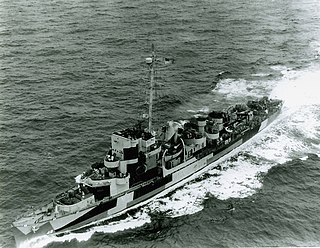
USS Dobler (DE-48) was an Evarts class destroyer escort constructed for the United States Navy during World War II. She was sent off into dangerous North Atlantic Ocean waters to protect convoys and other ships from German submarines and fighter aircraft. She performed escort and antisubmarine operations in battle areas before sailing home victorious at the end of the conflict.

USS Seid (DE-256) was an Evarts-class destroyer escort of the United States Navy in service from 1943 to 1945. She was scrapped in 1947.
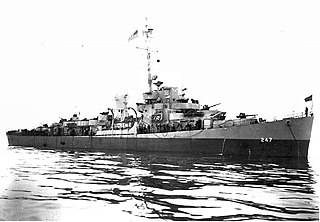
USS Stanton (DE-247) was an Edsall-class destroyer escort built for the U.S. Navy during World War II. She served in the Atlantic Ocean the Pacific Ocean and provided destroyer escort protection against submarine and air attack for Navy vessels and convoys.
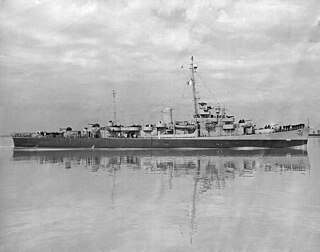
USS Mosley was an Edsall-class destroyer escort built for the U.S. Navy during World War II. She served in the Atlantic Ocean the Pacific Ocean and provided destroyer escort protection against submarine and air attack for Navy vessels and convoys.
USS Cymophane (PYc-26) was a Cymophane-class patrol yacht acquired by the United States Navy early during World War II. She was used for patrol, escort, anti-submarine, and rescue operations along coastal waters.



















